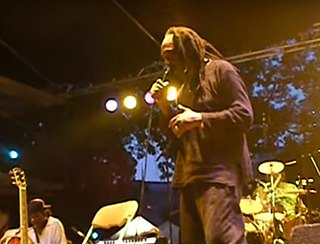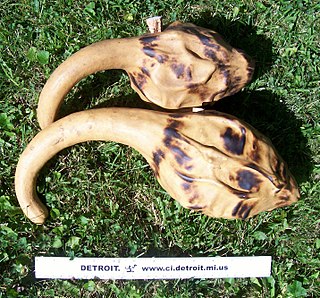
The xylophone is a musical instrument in the percussion family that consists of wooden bars struck by mallets. Like the glockenspiel, the xylophone essentially consists of a set of tuned wooden keys arranged in the fashion of the keyboard of a piano. Each bar is an idiophone tuned to a pitch of a musical scale, whether pentatonic or heptatonic in the case of many African and Asian instruments, diatonic in many western children's instruments, or chromatic for orchestral use.

Mbira are a family of musical instruments, traditional to the Shona people of Zimbabwe. They consist of a wooden board with attached staggered metal tines, played by holding the instrument in the hands and plucking the tines with the thumbs, the right forefinger, and sometimes the left forefinger. Musicologists classify it as a lamellaphone, part of the plucked idiophone family of musical instruments. In Eastern and Southern Africa, there are many kinds of mbira, often accompanied by the hosho, a percussion instrument. It is often an important instrument played at religious ceremonies, weddings, and other social gatherings. The "Art of crafting and playing Mbira/Sansi, the finger-plucking traditional musical instrument in Malawi and Zimbabwe" was added to the UNESCO Representative List of the Intangible Cultural Heritage of Humanity in 2020.

Zimbabwean music is heavily reliant on the use of instruments such as the mbira, Ngoma drums and hosho. Their music symbolizes much more than a simple rhythm, as the folk and pop style styled music was used as a symbol of hope for Zimbabweans looking to gain independence from Rhodesia. Music has played a significant role in the history of Zimbabwe, from a vital role in the traditional Bira ceremony used to call on ancestral spirits, to protest songs during the struggle for independence. The community in Zimbabwe used music to voice their resistance to their oppression, as one of the only weapons they had available to fight back with. In the eighties, the Music of Zimbabwe was at the center of the African Music scene thanks to genres such as Sungura and Jit. However, several performers were banned by state TV and radio leading to the closing of several music venues.

Thomas Tafirenyika Mapfumo is a Zimbabwean musician. He is nicknamed "The Lion of Zimbabwe" and "Mukanya" for his immense popularity and for the political influence he wields through his music, including his sharp criticism of the government of former Zimbabwean president Robert Mugabe. He both created and popularized Chimurenga music, and is known for his distinctive voice and slow-moving style.

The hosho are Zimbabwean musical instruments consisting of a pair of maranka (mapudzi) gourds with seeds. They are used as major instruments in many traditional Shona music genres, such as in mbira ensembles and in mhande. They typically contain hota seeds inside them. Before the hota seeds are added, the hosho is boiled in salted water and the inside is scraped out with a corncob, newspaper plug, or woven wire. Removing the debris inside the hosho allows for a more sharp and percussive tone.
Ephat Mujuru (1950–2001), was a Zimbabwean musician, one of the 20th century's finest players of the mbira, a traditional instrument of the Shona ethnic group of Zimbabwe.
Abraham Dumisani Maraire, known to friends as "Dumi", was a Zimbabwean musician. He was a master performer of the mbira, a traditional instrument of the Shona people of Zimbabwe. He specialized in the form of mbira called nyunga nyunga, as well as the Zimbabwean marimba. He introduced Zimbabwean music to North America, initiating a flourishing of Zimbabwean music in the Pacific Northwest that continues into the 21st century.

The Shona people are a Bantu ethnic group native to Southern Africa, primarily living in Zimbabwe where they form the majority of the population, as well as Mozambique, South Africa, and a worldwide diaspora. There are five major Shona language/dialect clusters: Manyika, Karanga, Zezuru, Korekore, and Ndau.

Stella Chiweshe was a Zimbabwean musician. She was known internationally for her singing and playing of the mbira dzavadzimu, a traditional instrument of the Shona people of Zimbabwe. She was one of few female players, and learned to play from 1966 to 1969, when other women did not.

Hugh Travers Tracey was an English ethnomusicologist. He and his wife collected and archived music from Southern and Central Africa. From the 1920s through the 1970s, Tracey made over 35,000 recordings of African folk music. He popularized the mbira internationally under the name kalimba.
Erica Kundidzora Azim is a musician who has worked in Zimbabwe and Berkeley, California, she is known for her expertise with Shona mbira music. She collaborates with Fradreck Mujuru who also makes traditional instruments. The two of them have played together in 2016 in America.

Forward Kwenda is a mbira performer from Zimbabwe. He was given the name "Forward" due to his involvement in many activities including his performances for guerrilla forces during the Rhodesian Bush War.
Articles related to Zimbabwe include:

Chiwoniso Maraire was a Zimbabwean singer, songwriter, and exponent of Zimbabwean mbira music. She was the daughter of Zimbabwean mbira master and teacher Dumisani Maraire. Describing the mbira, an instrument traditionally used by male musicians, she said, "It is like a large xylophone. It is everywhere in Africa under different names: sanza, kalimba, etc. For us in Zimbabwe it is the name for many string instruments. There are many kinds of mbiras. The one that I play is called the nyunga nyunga, which means sparkle-sparkle."

Dancing in Zimbabwe is an important aspect of the Zimbabwean culture, tradition, spirituality and history. There are many dances that reflect the culture of the people, although the dances may have changed throughout the years. Ethnic diversity is also a key factor in influencing the dances of the Zimbabwean culture. These dances are self-reflective, for the entire community because all music and dance are communal events. Dance to Zimbabweans is a very spiritual, powerful tool that carries on traditions, and chronicles the important events of their history and culture.

Pieces of Africa is a 1992 studio album by the Kronos Quartet, containing works commissioned by the quartet, written by seven African composers.

Peter Mujuru, known by his mononym Mashasha, is a Zimbabwean musician, bass guitarist, singer, songwriter and producer based in the UK. He is widely regarded as an original and important new voice in African music. His debut studio album, Mashasha, which was released by Elegwa Music in 2011; it was acclaimed by critics internationally and won a Zimbabwe Music and Arts (ZIMAA) award for Best Album.

Mbira DzeNharira was formed by Tendayi Gahamadze in 1987 in Norton, a town 40 km west of Harare. To date they have released 11 CD and 3 DVD albums.















